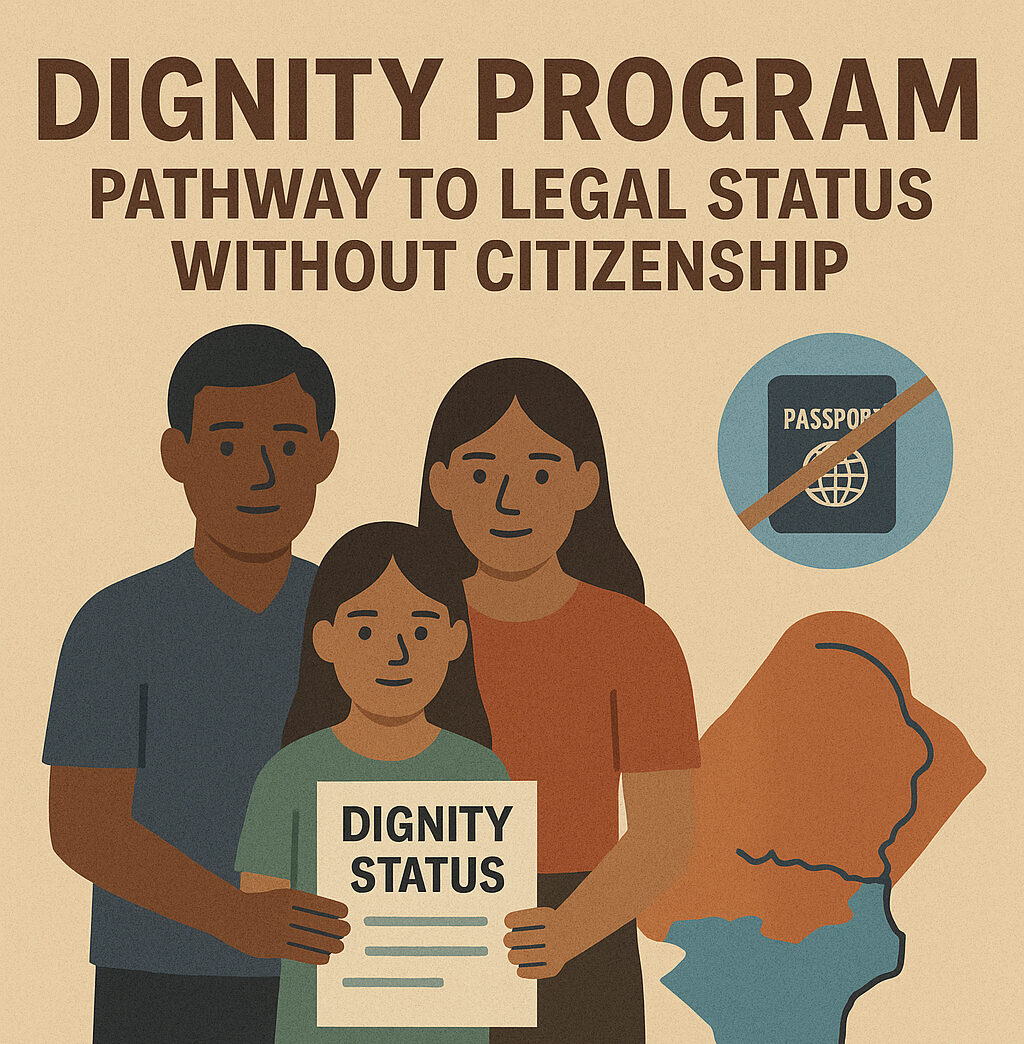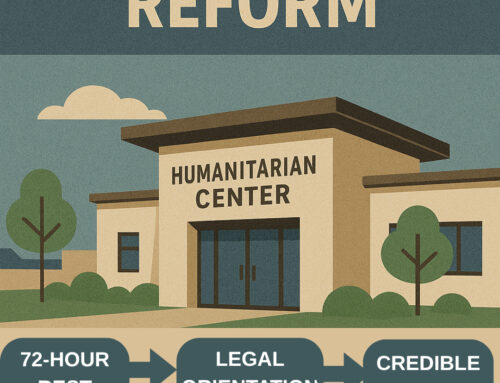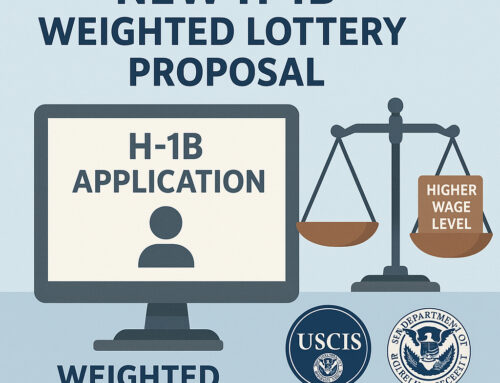OVERVIEW OF THE REINTRODUCED DIGNITY ACT: A COMPREHENSIVE IMMIGRATION REFORM PROPOSAL
On July 15, members of Congress unveiled a rare piece of bipartisan immigration reform legislation: the Dignity Act. This wide-ranging bill aims to address persistent and deeply rooted issues in the U.S. immigration system, which has seen little substantive reform since the 1990s.
The core concept of the Dignity Act involves balancing stronger immigration enforcement—particularly at the U.S.-Mexico border—with significant reforms to the legal immigration framework and a new mechanism for granting lawful status to long-term undocumented residents.
Unlike previous proposals that offered more limited adjustments, the Dignity Act proposes a broad and structured avenue for nearly all undocumented immigrants who have lived in the U.S. since before December 31, 2020, to gain permanent legal status (though not citizenship). In return, the bill seeks to overhaul border processing for asylum seekers, make E-Verify mandatory nationwide, and introduce new criminal penalties for immigration-related violations.
While the bill’s passage remains uncertain given the current political landscape, it signals ongoing bipartisan interest in negotiating real immigration reform. At a time when enforcement efforts are intensifying, public support for immigration and pathways to permanent residency appears to be growing, possibly setting the stage for renewed legislative momentum.
Main Legalization Pathway: The Dignity Program
The original 2023 version of the bill introduced a two-phase program: the “Dignity” Program and the “Redemption” Program. The updated version removes the latter and replaces it with “Dignity Status,” a new category of non-immigrant status that allows undocumented immigrants to remain in the U.S. with permission to work and travel—but without a direct path to citizenship or the ability to petition for family members.
To qualify for the Dignity Program, applicants must meet several conditions:
-
Have lived in the U.S. for at least five years
-
Voluntarily come forward and acknowledge their undocumented status
-
Clear a criminal background check
-
Pay a $1,000 application fee
If approved, participants would receive legal permission to stay in the country for seven years. Those who don’t qualify would be given a 12-month grace period to leave voluntarily without being subject to the current 3- or 10-year reentry bans.
Throughout the seven-year program, participants must report to the Department of Homeland Security every two years, demonstrate good community standing, and pay a total of $6,000 in additional fees ($1,000 minimum per visit). These funds would help support the national rollout of E-Verify and invest in workforce development programs.
Dignity Program participants must also meet certain work or education requirements, though exceptions exist for dependents and seniors. An additional 1% tax would be imposed on participants, balanced by an exemption from FICA taxes, as they would not be eligible for Social Security, Medicare, or other federal benefits.
Upon completion, individuals would receive “Dignity Status,” a renewable, seven-year non-immigrant designation that offers protection from deportation and authorization to work and travel indefinitely. This status, however, would not lead to citizenship or allow family reunification through sponsorship.
While this shift from permanent residency to renewable non-immigrant status may disappoint some immigrant rights advocates, it may appeal to lawmakers who are hesitant to support citizenship for the undocumented population.
Additional Legalization Options in the Bill
The original version of the Dignity Act also included three separate legalization paths outside of the Dignity Program—for Dreamers, TPS holders, and undocumented farmworkers. In the 2025 version, only the Dream Act provision remains.
The revised Dream Act allows certain undocumented immigrants who entered the U.S. as minors to apply for green cards if they meet specific criteria. Eligible individuals must:
-
Have arrived before the age of 18
-
Earn a degree from a college or graduate program, serve at least three years in the military, or be employed for four years
-
Demonstrate English proficiency and pass a civics exam
Earlier projections suggested that two to three million people could benefit under this framework. While protections for TPS recipients have been scaled back, those individuals would be exempt from paying the Dignity Program’s $7,000 fee. Provisions for farmworkers have been removed entirely.
Changes to Immigration and Border Enforcement
The Dignity Act initially proposed major funding increases for border infrastructure and staffing, but much of that was addressed in the recently passed One Big Beautiful Bill Act. Although additional funding is no longer included, several enforcement provisions remain:
-
Enhanced criminal penalties for unauthorized border crossings
-
New penalties targeting “spotters” who assist smugglers by tracking border agents
-
Legal authority for DHS to bypass certain regulations for building new barriers and deploying surveillance technology
-
Mandatory nationwide use of E-Verify, with strict penalties for non-compliant employers
-
Full biometric screenings for any sponsor of an unaccompanied child
The bill also increases penalties for submitting fraudulent asylum claims and gives USCIS greater latitude to reject such applications. Proven fraud could lead to criminal prosecution.
Overhaul of the Asylum Process
One of the bill’s most significant reforms involves restructuring how asylum is processed at the border. The Department of Homeland Security would be required to build at least three large “humanitarian campuses” near the southern border. These facilities, designed to be less punitive than traditional detention centers, would serve as processing hubs staffed by federal agencies, nonprofit organizations, legal providers, and caseworkers.
At these centers:
-
Migrants would receive a 72-hour rest period, during which background checks and DNA tests would be conducted
-
A legal orientation would follow, then a credible fear interview within 15 days
-
Each case would be reviewed by two asylum officers simultaneously
If both officers agree the applicant qualifies for asylum, status would be granted immediately. If both reject the claim, it would be denied. Disagreement between officers would send the case to an immigration judge for further review.
Applicants denied asylum would have one appeal opportunity before a new panel of officers. If rejected again, a final removal order would be issued with no option for judicial review—unless the case was referred to a judge due to complexity or the applicant was considered part of a vulnerable group.
Some migrants would be eligible for pre-screening in Latin American countries. If they present compelling evidence of persecution, they could be granted a visa to enter the U.S. legally, subject to the annual refugee cap.
Proposed Reforms to Legal Immigration
The Dignity Act includes several measures aimed at modernizing the legal immigration system and reducing extreme visa backlogs. Key provisions include:
-
Limiting visa wait times to a maximum of 10 years by 2035
-
Raising per-country visa caps from 7% to 15%
-
Exempting spouses and children of employment-based green card applicants from annual visa limits, effectively doubling available visas
-
Resolving the “documented Dreamer” issue, allowing children of temporary visa holders to remain after age 21
Other proposed legal immigration updates:
-
Student visa holders would be allowed to have dual intent, making it easier to transition to permanent residency after graduation
-
Applicants for O-1 visas (extraordinary ability) could qualify based on holding a PhD in STEM, healthcare, or medicine
-
A new “family purpose” visitor visa would permit U.S. citizens and green card holders to bring relatives for short-term visits, such as weddings or funerals
-
Expedited naturalization through military service would become available
To accommodate the anticipated increase in application volume, the bill includes over $3.6 billion in funding for backlogged agencies, including USCIS, the State Department, and the Department of Labor.
What Comes Next?
While it remains to be seen whether the Dignity Act will advance through Congress, its reintroduction signals a continuing interest in meaningful immigration reform. Even with controversial provisions, the bill illustrates that some lawmakers are still pursuing bipartisan solutions to one of the country’s most divisive issues. If any reform is to succeed, proposals like the Dignity Act may serve as a critical foundation for negotiation and compromise.
About the Author
Elizabeth Garvish
Elizabeth L.A. Garvish founded Garvish Immigration Law Group, LLC in 2011 after practicing immigration law in small boutique firms, big law and nonprofits. Elizabeth is a frequent speaker and presenter on entrepreneurship and U.S. immigration topics around the world. She is an active member of the American Immigration Lawyers Association (AILA) and serves on various national committees and is the Past Chair of the Georgia-Alabama Chapter of AILA. Elizabeth is also a certified member of the EO Global Speakers Academy.





